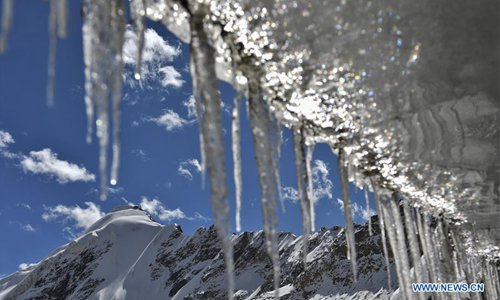HOME >> CHINA
20 percent glacier coverage lost in four decades in China
By Deng Xiaoci Source:Global Times Published: 2019/12/23 18:48:39

Photo taken on Oct. 16, 2019 shows the scenery of the Korchung Kangri glacier in Gyaidar Village in Damxung County of southwest China's Tibet Autonomous Region. The Korchung Kangri Glacier Park, 160 kilometers from Lhasa, is located in Gyaidar Village in Damxung County at an altitude of 5,500 meters. The park integrating glaciers, lakes and meadows is an unique ecological tourist area. Photo: Xinhua/Sun Fei
China has lost around one-fifth of its total glacier coverage from 1970 to 2010, official research data shows, which astonished internet users on Monday and made them call for practical measures to reduce carbon emissions and address the problem.China, a country said to have the richest glacier resources in the low and middle latitude, in the 1970s had 48,410 glaciers across more than 60,500 square kilometers, according to the first national glacier study category. China's glacier coverage fell to 48,000 square kilometers in 2010, a drop over 20 percent, the Guangming Daily reported, citing researchers on Monday.
Some 8,300 glaciers have totally disappeared in China and Southwest China's Tibet Autonomous Region has suffered from the heaviest glacier loss in China: 7,680 square kilometers of glaciers have melted in the region over the period, a coverage loss of around 27.7 percent.
Southwest China's Yunnan Province ranked second on the list, the report said.
Yang Wei, an associate research fellow with the Institute of Tibetan Plateau Research under the Chinese Academy of Sciences (CAS) in Beijing, told the Global Times that the main reason for the glacier melting was global warming caused by greenhouse gas emissions.
Wu Guangjian, another research fellow with the institute said that the temperature in the Tibet-Qinghai Plateau climbed up 0.4 C a decade, about twice as much as the world average.
Chen Renping, a researcher with the CAS Northwest Institute of Eco-Environment and Resources, underlined that the loss of glaciers would also indicate a loss of water resources.
He likened glaciers to a reservoir of water in solid form. They play an important supplementary and regulatory role to water bodies including rivers and streams.
China's cryosphere is the headstream of key rivers not only in China but in neighboring countries, and more importantly, it is the water tower for countries and regions along the Belt and Road route, nourishing a vast population, he explained.
Multiple glacier avalanches between 2016 and 2018 in Tibetan areas have sounded a "white alarm," the report said.
The range of glacier avalanches is expanding and glaciers in the Qinghai-Tibet region have likely become unstable.
The Qinghai-Tibetan plateau's meltwater feeds 10 great rivers in Asia and affects 1.9 billion people, according to media reports.
The hashtag #onefifthglaciermeltedinChina became one of the top 10 most discussed topics on China's Twitter-like Sina Weibo as of Monday night, gathering over 160 million reads and 17,000 comments.
Many called for actual measures, starting with daily life, to reduce carbon emissions.
Some Net users said they were especially worried about animals inhabiting the glacier environment.
"Where will they go if their habitats are ruined by human beings?" posted one typical user.
Posted in: SOCIETY